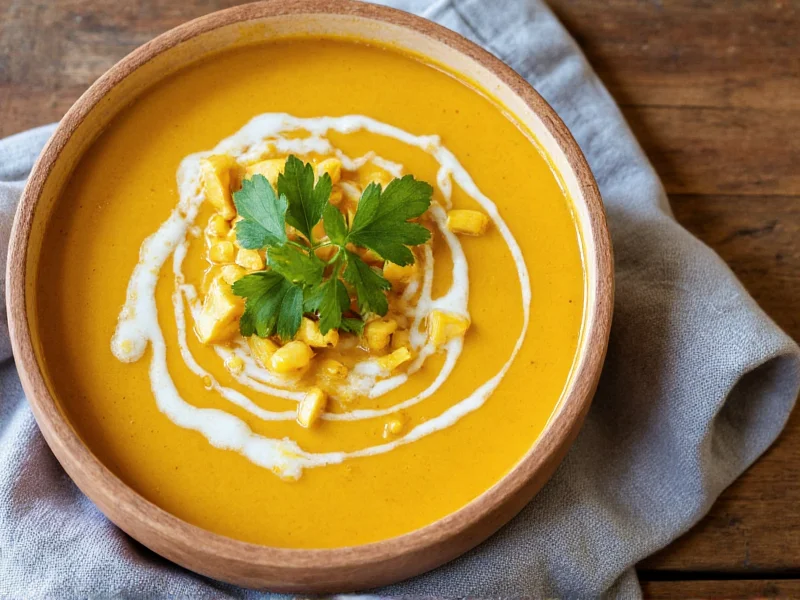The Essence of Coconut Curry Soup
Coconut curry soup represents one of Southeast Asia's most beloved culinary creations, particularly in Thai cuisine where it's known as tom kha gai. This aromatic soup combines the rich creaminess of coconut milk with the complex heat of curry spices to create a harmonious flavor profile that has gained international popularity. Unlike Western cream-based soups, authentic coconut curry soup achieves its luxurious texture entirely from coconut milk, making it suitable for dairy-free and vegan diets when prepared with plant-based proteins.
Historical Roots and Cultural Significance
Originating in Thailand centuries ago, coconut curry soup emerged from the country's abundant coconut groves and spice trade routes. Traditional tom kha (literally 'galangal soup') evolved as Thai cooks incorporated Indian curry influences with local ingredients. The soup's development reflects Thailand's culinary philosophy of balancing the five fundamental tastes: spicy, sour, sweet, salty, and umami. In Thai households, variations of coconut curry soup appear regularly in meal rotations, often prepared with whatever fresh ingredients are available that day.
Essential Ingredients and Their Roles
The magic of authentic Thai coconut curry soup recipe lies in its ingredient synergy. Each component serves a specific purpose in creating the soup's distinctive character:
| Ingredient | Function | Traditional Substitutes |
|---|---|---|
| Coconut milk | Creates creamy base, balances heat | Coconut cream diluted with water |
| Curry paste | Provides foundational flavor and heat | Homemade paste from fresh ingredients |
| Lemongrass | Adds citrusy aroma, subtle sweetness | Lemon zest (less authentic) |
| Galangal | Earthy, pine-like flavor (distinct from ginger) | Ginger (different flavor profile) |
| Kaffir lime leaves | Floral citrus notes, signature aroma | Lime zest (less complex) |
Step-by-Step Preparation Guide
Creating an exceptional homemade coconut curry soup requires attention to technique as much as ingredients. Start by gently simmering aromatics—lemongrass, galangal, and kaffir lime leaves—in broth before adding curry paste. This 'blooming' process unlocks essential oils and deepens flavor complexity. When incorporating coconut milk, avoid boiling to prevent separation; maintain a gentle simmer throughout cooking.
For optimal texture in your easy coconut curry soup for beginners, add proteins like chicken or shrimp during the last 5-7 minutes of cooking. Vegetables such as mushrooms, bamboo shoots, and bell peppers should be added according to their cooking times—heartier vegetables first, delicate greens last. Finish with fresh lime juice and cilantro to brighten flavors just before serving.
Regional Variations Worth Exploring
While Thai coconut curry soup remains most famous, regional adaptations offer exciting alternatives. Malaysian versions often include tamarind for pronounced sourness, while Indonesian interpretations might feature additional spices like candlenut. For those seeking vegetarian coconut curry soup variations, Japanese adaptations sometimes incorporate miso paste for umami depth. Coastal regions frequently feature seafood prominently, with coconut curry soup with shrimp representing a popular coastal Thai variation.
Avoiding Common Preparation Mistakes
Many home cooks encounter issues when first attempting this dish. The most frequent error involves boiling coconut milk vigorously, causing separation and an oily texture. Another common mistake is using curry powder instead of authentic curry paste, resulting in a fundamentally different flavor profile. For best coconut milk for curry soup, select full-fat varieties without additives—shake the can thoroughly before opening to ensure proper emulsion.
Nutritional Profile and Health Considerations
Coconut curry soup health benefits include being naturally dairy-free and rich in medium-chain triglycerides from coconut milk, which some studies suggest may support metabolism. The soup provides a balanced mix of healthy fats, protein, and vegetables. When prepared traditionally, it contains no added sugars, relying instead on natural sweetness from coconut and vegetables. For lower-calorie versions, light coconut milk works acceptably though it sacrifices some creaminess.
Serving Traditions and Pairings
In Thailand, coconut curry soup typically serves as part of a multi-dish meal rather than a standalone course. It complements jasmine rice perfectly and often appears alongside other curries and stir-fried dishes. For Western presentations, serving in smaller portions as a starter works well. Traditional garnishes include fresh cilantro, sliced red chilies, and a squeeze of lime. When exploring gluten-free coconut curry soup options, verify that curry paste ingredients don't contain wheat-based thickeners.
Frequently Asked Questions
What's the difference between tom kha and tom yum soup?
Tom kha features coconut milk as a primary ingredient, creating a creamy, milder soup with balanced flavors. Tom yum is a clear, hot and sour broth without coconut milk, known for its intense spiciness and tanginess. Both use similar aromatics like lemongrass and kaffir lime leaves, but their base ingredients create distinctly different culinary experiences.
Can I make coconut curry soup without fish sauce?
Yes, you can create authentic-tasting vegetarian coconut curry soup by substituting fish sauce with soy sauce or tamari for gluten-free options. For deeper umami, combine soy sauce with a small amount of mushroom broth. Traditional Thai vegetarian versions sometimes use fermented soybean paste as an alternative to fish sauce while maintaining complex flavor profiles.
How do I prevent coconut milk from separating in curry soup?
Maintain gentle heat—never allow coconut milk to reach a rolling boil. Keep soup at a bare simmer (180-190°F/82-88°C). When adding curry paste, first mix it with a small amount of broth to create a slurry before incorporating into coconut milk. High-quality full-fat coconut milk with guar gum as the only stabilizer tends to resist separation better than 'light' varieties or those with multiple additives.
What protein works best in coconut curry soup?
Traditional Thai versions use chicken (tom kha gai), but shrimp (tom kha kung) offers excellent flavor pairing with coconut. For vegetarian options, firm tofu or mushrooms like shiitake provide satisfying texture. Regardless of protein choice, add it during the final 5-7 minutes of cooking to prevent overcooking. Pre-cooked proteins work well for quick assembly of easy coconut curry soup for beginners.











 浙公网安备
33010002000092号
浙公网安备
33010002000092号 浙B2-20120091-4
浙B2-20120091-4